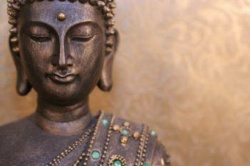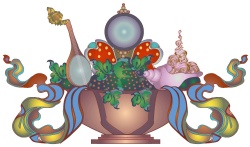Waterbowl Offerings
By Kyabje Lama Zopa Rinpoche
Dharamsala , India (Archive #518)
Advice on how to make waterbowl offerings, excerpted from a teaching given by Lama Zopa Rinpoche at Tushita Meditation Centre, Dharamsala, India, on April 13, 2007. Edited by Ven. Ailsa Cameron.
In order to make waterbowl offerings, first generate a motivation of bodhicitta with the thought, "I'm going to make these waterbowl offerings in order to achieve enlightenment for the benefit of all sentient beings."
When you clean the bowls, just as when you clean the meditation room in the preparatory practice of Jorchö, you can think that you are cleaning away the two obscurations of yourself and of all sentient beings. Think of whatever you are using to clean the bowls as the method and wisdom of the whole path to enlightenment, with which you are cleaning away the two obscurations. Relate the image to whichever meditation you are training in. For example, if you are meditating on impermanence and death, think that you are cleaning away the conception of permanence. If you are meditating on abandoning the eight worldly dharmas, think that you are cleaning away these wrong conceptions to which you are clinging.
You pile the bowls one on top of the other, then recite OM AH HUM three times as you fill the top bowl with water. During a Jorchö commentary, His Holiness Serkong Tsenshab Rinpoche explained that because you cannot set empty bowls on the altar, so then you pour most of the water from the top bowl into the next bowl, then set the top bowl on the altar. You then pour most of the water from the second bowl into the third bowl and place the second bowl on the altar.
The lam-rim teachings mention that you should not place the bowls too far apart as this makes you distant from your gurus. And placing the bowls so that they touch each other becomes a condition to have a dull mind. You should leave a little space between the bowls.
The bowls should be beautifully arranged, without crookedness. The main point is that you should make the offering without cunning or deceit. The best offering is one made with a mind unstained by the eight worldly dharmas.
Once the bowls are lined up, you fill them with water. When you offer the water, start with a small stream, then a large stream, then finish with a small stream again. His Holiness Zong Rinpoche said that this helps to reduce the noise that you make. Since making a lot of noise creates a disturbed or unstable mind, it is good to offer the water as quietly as possible.
When you pour the water into the bowls, you should not overfill them, because if the water spills out, it becomes a condition for the degeneration of pure morality. According to the instructions of the lineage lamas of lam-rim, you should leave a small space the size of a grain below the rim of the bowl. Some of the bowls made in India and Nepal have a line around the top to mark the water level.
While you are offering the water, you can recite the mantra of blessing that causes all the buddhas to receive clouds of offerings: OM NAMO BHAGAVATE...*
While you are offering, you can think like this to create more merit. On your altar are many pictures or statues of buddhas, and whether you are offering one waterbowl or many, in their view you are offering nectar. The most important point is to think that all the many representations of Buddha on your altar are embodiments of all your gurus and you are offering to your gurus. Among the holy objects, the guru is the highest, most powerful object. You can also think that the guru is all the buddhas; the guru is the embodiment of all the objects of refuge, Buddha, Dharma, and Sangha. They generate infinite bliss in their holy minds. Even if you have only one altar with one statue of Buddha, by thinking that it is the guru and offering each bowl, you immediately accumulate so much merit.
When you have finished offering all the bowls, you should think that there are numberless offerings, that the whole of space is filled with nectar offerings. The more extensively you can think, the more merit you accumulate. Think that even a tiny drop of that nectar generates infinite bliss. The bliss that is generated cannot fit in the sky.
Besides thinking that the pictures and statues on your altar are the embodiments of all the gurus, Buddha, Dharma, and Sangha, you can even think of all the holy objects in the ten direction: all the statues, scriptures, and stupas. In essence, the absolute nature of this is also the absolute nature of all the holy objects in the ten directions. When you have finished offering to the actual living gurus, Buddha, and Sangha, you can again offer the nectar to all those in the ten directions and generate infinite bliss in their holy minds. You can again offer to all the holy objects in the ten directions. By thinking in these different ways and offering again and again, you accumulate unbelievable merit in that half-hour or in that few minutes.
After this, you dedicate the merit. His Holiness Serkong Tsenshab Rinpoche used to explain that first you completely dedicate the merit and all its good results of temporary and ultimate happiness up to enlightenment to each sentient being: each hell-being, preta being, animal being, human being, deva being. Just as with the giving practice in tong-len, you give everything to each sentient being. With this dedication you have again accumulated infinite merit. Rinpoche used to say, "May sentient beings receive and experience whatever merit and happiness I have accumulated. And may I receive and experience upon myself whatever sufferings sentient beings have." Dedicate in this way. And after that, you can dedicate to achieve enlightenment for the sake of all sentient beings.
It is important not to forget to dedicate for bodhicitta. Dedicating to generate bodhicitta is one of the practices of the five powers and a means of accumulating extensive merit. We can dedicate like this after finishing prostrations or any other of the preliminary practices.
You then tip out the water. After you have emptied the water from the bowls, you should not throw it on dirty ground or where it will be walked on. This applies generally to anything, such as flowers, offered on an altar. You should throw the water in a flower garden or somewhere clean. Remember that this is an offering to the Triple Gem and it has been taken by the Triple Gem.



